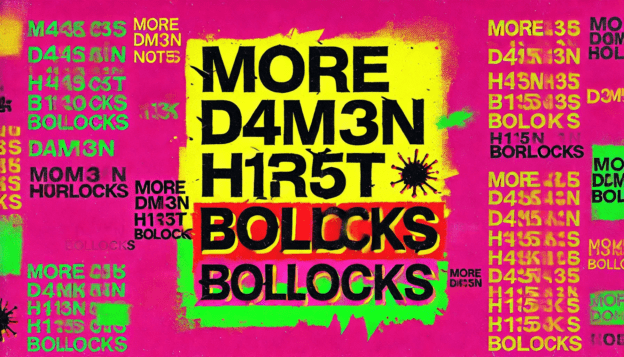Damien Hirst, the enfant terrible of the art world, the man who turned dead animals into million-dollar spectacles and placed a skull encrusted with diamonds at the pinnacle of contemporary art. Critics call him a genius; others see him as the ultimate conman. But one thing’s for sure: Hirst has built an empire of bollocks as big and brash as his installations.
Let’s dissect the myths, the marketing, and the outright absurdities that define the Damien Hirst phenomenon, in part 32 of my satirical comedic polemic series.
“Hirst Redefined Art”
Hirst is often credited with redefining contemporary art, thanks to works like The Physical Impossibility of Death in the Mind of Someone Living (you know, the shark in a tank) and Mother and Child (Divided) (a bisected cow and calf preserved in formaldehyde). Sure, these pieces are provocative, but are they art or just biology lessons with better lighting?
Preserving dead animals and sticking them in glass tanks may have been shocking in the ’90s, but it’s hardly innovative. It’s more like something you’d see at a slightly morbid natural history museum. The claim that Hirst redefined art? Suspiciously preserved bollocks.
“The Skull Is a Masterpiece”
For the Love of God, the diamond-encrusted human skull, is perhaps Hirst’s most infamous work. Valued at £50 million, it was hailed as a profound meditation on mortality. But strip away the diamonds, and what are you left with? A flashy symbol of excess and art-market decadence.
The piece was supposedly purchased by a group of investors, including Hirst himself, a fact that raises eyebrows about its supposed value. The idea that this gaudy, glittery skull is a profound statement? It’s shiny bollocks with a hefty price tag.
“His Art Is Deeply Conceptual”
Hirst’s defenders argue that his work is loaded with deep meaning, exploring themes like death, decay, and the fragility of life. But let’s be honest: many of his pieces feel like they were dreamed up in five minutes at a particularly rowdy pub. Medicine cabinets filled with pills? A dot painting? A fish in formaldehyde? Where’s the depth?
The idea that Hirst’s work is a rich tapestry of existential philosophy is overintellectualized bollocks designed to justify absurd auction prices.
“Hirst Is a Self-Made Genius”
Hirst loves to frame himself as the scrappy outsider who made it big with talent and determination. But let’s not forget his connections: he was backed by Charles Saatchi, the advertising mogul turned art collector, who bankrolled much of his early career. Hirst didn’t storm the art world on his own; he rode in on a wave of Saatchi-funded PR.
The notion that Hirst is a self-made genius is mythologized bollocks. He’s more of a well-connected opportunist who knew how to play the game.
“The Spin Paintings Are Iconic”
Hirst’s spin paintings, created by splattering paint on a spinning canvas, are often cited as examples of his genius. But let’s be real: spin art is what kids do at carnivals. It’s messy, fun, and utterly devoid of innovation. Hirst just scaled it up, slapped on his name, and called it art.
The idea that these paintings are iconic is childish bollocks dressed up in gallery lighting.
“He Made the Art World Accessible”
Hirst’s populist appeal is often celebrated, with claims that he brought contemporary art to the masses. But accessible? His works sell for millions, his exhibitions cater to the elite, and his most famous pieces are locked away in private collections or museums. The average person can engage with Hirst’s art only through overpriced merchandise or grainy Instagram photos.
The claim that Hirst made the art world accessible is marketing bollocks designed to distract from the exclusivity of his empire.
“The Market Proves His Genius”
One of the most persistent defenses of Hirst is that his art commands astronomical prices, which must mean it’s good, right? Wrong. The art market is less about talent and more about brand-building, scarcity, and wealthy collectors flexing their financial muscles. Hirst’s genius lies not in his art but in his ability to game this system.
The notion that market value equals artistic merit is capitalist bollocks masquerading as cultural commentary.
“The Medicine Cabinets Are Profound”
Hirst’s medicine cabinet series, featuring shelves filled with pills and medical paraphernalia, is supposed to symbolize humanity’s reliance on science to cheat death. But if you strip away the artspeak, what you’ve got is a glorified display case that wouldn’t look out of place in a pharmacy.
Profound? Hardly. It’s minimalist bollocks dressed up as deep thought.
“He Challenges the Art Establishment”
Hirst likes to position himself as a rebel taking on the pretentiousness of the art world. But let’s not forget that he’s one of its biggest beneficiaries. His works fetch obscene prices, he owns a multimillion-pound estate, and he’s as establishment as it gets. The idea that Hirst is challenging anything is hypocritical bollocks.
“Hirst’s Legacy Will Endure”
Fans argue that Hirst’s work will stand the test of time, securing his place among the greats. But will future generations really look at a diamond skull or a shark in a tank with the same reverence as a Van Gogh or a Picasso? Or will they see it as a relic of an era when the art world lost its mind chasing money and spectacle?
The claim that Hirst’s legacy is untouchable feels like speculative bollocks at best.
Conclusion: The Emperor’s New Formaldehyde
Damien Hirst is undeniably a skilled marketer and showman, but his reputation is built as much on spectacle and PR as it is on artistic talent. From overpriced trinkets to rehashed ideas, much of his oeuvre feels more like a hustle than a profound statement.
Hirst may not be shit, but the mountains of bollocks surrounding his name make it hard to see where the art ends and the con begins.
